« A greener lake | Main | How to deal with sharks »
July 6, 2009
A great dive trip, for less
Sometimes I wonder why people go on expensive dive trips far away when for much less they can explore all sorts of terrific diving much closer to home. There's nothing wrong with planned trips to exotic locations, but if at times they seem a bit too dear, the traveling a bit too exhausting, and the venues a bit too crowded, there are great alternatives that don't compromise on diving and cost much less. I realized that again on a recent trip to Florida that combined business and pleasure and let me enjoy seven wonderful and varied dive locations all within an hour or two of Orlando. The round trip from Sacramento to Orlando was just US$220, diving cost little, as did staying in some nice places in central Florida. Cost was probably a good deal less than half of a "real" dive trip, and that includes renting a car, tanks and weights for the week.
Crystal River, Florida
Snorkeling with Manatees in Crystal River, which is about 90 miles northwest of Orlando on the Gulf coast, is such a unique experience that I’ll take every chance I get to see those gentle, wonderful creatures again. Mid June didn’t seem like an optimal time for manatee sightings, though, and Captain Chris at the Birds Underwater dive shop and tour operator confirmed this.  The manatees migrate up the rivers and springs when the seawater gets cold but then leave again when it gets warmer. It might take quite some time to locate a manatee or two, said Chris, and the water conditions were not optimal, with a very noticeable amount of dead algae clumps floating on the surface. There was none of that early morning mist hovering on the water either as the sun was already high up in the sky at 7AM this time of year. Still, the freshwater King’s Bay area was as majestic and serene as ever.
The manatees migrate up the rivers and springs when the seawater gets cold but then leave again when it gets warmer. It might take quite some time to locate a manatee or two, said Chris, and the water conditions were not optimal, with a very noticeable amount of dead algae clumps floating on the surface. There was none of that early morning mist hovering on the water either as the sun was already high up in the sky at 7AM this time of year. Still, the freshwater King’s Bay area was as majestic and serene as ever.
We got lucky with the manatees, though, as Captain Chris spotted the tell-tale small bubbles that signal a manatee grazing at the bottom. Sometimes the bubbles turn out to be just fish or a turtle, but soon we saw a manatee surfacing to take a breath. You never see more than the top of their nose with the two nostrils while the rest off the animal stays underwater.
Everyone pulled up their wetsuit and donned fins and mask and in we went. Visibility was very marginal, perhaps five feet or even less. That was disappointing and I wondered why exactly it was that they called this place “Crystal River†when at least for now, and also on my first visit here, it was anything but. I mean, King’s Bay is where all the water of Crystal River originates is one giant spring, so you’d expect it to be clear.
Despite the murky water we did see manatees. A dark shape would slowly materialize in the water and all of a sudden I’d see the animal within a foot or two, slowly moving through the water, never bumping into me or touching me. I had a chance to touch its skin that felt a bit like rough neoprene. There were a mama manatee with two calves, the younger one perhaps four to five feet long and very curious and playful.
We followed the manatees for half an hour or so, then got back on the boat and headed for the entrance to Three Sisters, one of my favorite snorkeling areas with what usually is truly crystal-clear water. Snorkeling up through the picturesque rocky entrance I saw finned and bare legs and feet stirring up the bottom and couldn’t refrain from reprimanding one of the offenders. He first thought I was just making conversation, then realized that I was chewing him out and quickly turned away. I later felt bad for having done that as I surely didn’t want to ruin anyone’s experience of that magical spot. It just seems so unnecessary to spastically flail around and ruin visibility for everyone else when it’s so easy to stay flat in the water.
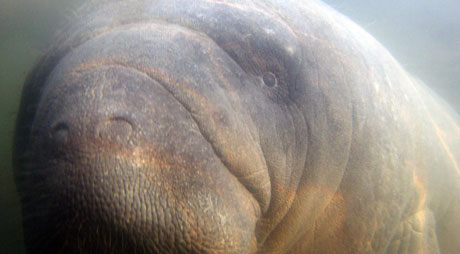
Three Sisters was the great experience I remembered, though it’d been infested by wispy green algae that clung to things like giant cottonballs and looked entirely out of place. Carol said she wanted to grab some of the green stuff, ball it up into ugly, nasty clumps and remove it from the water. Captain Chris had said this was normal for this time of the year and I sure hope it’ll go away again.
Back on the boat people took their wetsuits off a bit too soon as we saw another manatee, this time in clear water. I still wore my suit and got to go back in and follow and watch the manatee, which seemed to be a large male. Unfortunately I had left my camera on the boat and could not take pictures.
Rainbow River
Drift diving means that you enter the water in one place and exit at another. Which means you need someone to drop you off or pick you up. Last time, early in my dive career, I had been with a tour where the boat dropped us off somewhere in the upper part of Rainbow River and then collected us again at the end of the dive. Since the boat had been located in Crystal River, some 20 miles away from K.P. Hole State Park, the logistics of getting the boat there (on a trailer) and back were a bit difficult. Our friends at Bird’s Underwater don’t do that anymore, and so this time they made a call and arranged to have a boat take us upriver and drop us off.
 Captain Bill awaited us and soon we were on his boat, getting helpful tips and explanations along the way. The trip upriver for our planned hour-and-a-half drift dive seemed very short and so we asked the captain to take us up a bit farther before we jumped in the water.
Captain Bill awaited us and soon we were on his boat, getting helpful tips and explanations along the way. The trip upriver for our planned hour-and-a-half drift dive seemed very short and so we asked the captain to take us up a bit farther before we jumped in the water.
The dive itself was pretty much as I remembered, with depths varying from just a couple of feet or less all the way down to maybe 20 feet, water temperature a pleasant 75 degrees, and the current anywhere from barely noticeable to quite brisk. Visibility wasn’t great, but good enough to see where we were going. We resolved to stay close together.
A river drift dive is like river rafting, only there's a lot of scenery and up and down as you dive between, through and around what’s at the bottom. It’s easier to stop and look around, and there’s lots to see. There are meadows of sea grass separated by sandy runs and chutes, gulley and valley like rock formations of varying size, little springs with cold water boiling up through the bottom in numerous spots, impenetrable bamboo-like gardens and more. Apart from inquisitive small fish and some funny looking baby turtles we didn’t see much wildlife, though once Carol ran into an alligator gar.
About halfway through the dive I heard a strange sound that Carol later described as like bacon frying in a pan. It was rain, one of Florida's sudden downpours. We were looking up to the surface from maybe eight to ten feet and saw the rain drops hitting the surface, and we could clearly hear it. I'd never experienced that before.
You’d expect a drift dive to simply take you downriver with you going along for the ride, but in reality it isn’t that easy. You tend to meander this way and that, and sometimes there is no obvious current to follow. I’d watch for the eel grass leaning in the direction of the flow, but sometimes it just stands up straight and you have no idea where to go. So you just go forward until there’s a current again.
One time I followed Carol through thick eel grass and it just got shallower and shallower. Carol finned through the grass in an effort to find deeper water again and even her expert technique couldn’t keep things from getting stirred up quite a bit. That quickly turned into a partial and then total silt-out with my world turning all brown. By now I was perhaps in a foot and a half of water but it felt like getting stuck in all the brown and the grass. Though I knew that all I had to do was turn around and stick my head out of the water it wasn’t a very pleasant experience.
Soon the water was deep and clear again and we came upon a powerful spring that rushed out of a cavern. It was so strong that we could barely swim up to it. I forced myself close, holding on to some rocks, when I saw what seemed like glittering yellow nuggets in the sand and rock. I picked some up and they seemed heavy and did not flake. I thought it couldn’t possibly be gold, but who knew what might blast out of the earth and so I picked up a few and put them in a pocket in my BC. It later turned out to be thoroughly ordinary pebbles and I have no idea why they had looked like gold to me down there.
Carol surfaced several times to get directions and make sure we didn’t miss our exit on the river. What had seemed to be just a short distance turned out to be an almost two hour dive. It's shallow, though, and I actually still had air left in my 80-cubic foot rental tank at the end of the dive (and felt pretty good about that). It’d been fun and I’d do it again, but I’d do it on a sunny day. Without the sun shining through the water and illuminating things, the river seemed somewhat flat and a bit dreary.
Chiefland, Catfish Sink, Manatee Springs State Park
After staying at the historic Island Hotel in scenic Cedar Key, it was on to another of my favorite dive sites. Nine out of ten divers would probably take one look at the Catfish sinkhole at Manatee Springs State Park near Chiefland and then quickly pass, or maybe more like 99 out of a hundred. That’s because the entire surface is covered in a half inch thick layer of duckweed, those tiny plants that get everywhere without feeling slimy or unpleasant. Me, I wouldn’t miss a chance to dive into that layer and see the magical landscape underneath. Catfish is also the major entrance to one of the world's longest syphon caves at over 11,000 feet of explored passage.
 When we checked in at the ranger booth there was only one other dive party listed up on the board and so the chance for clear water was good. Donning my 7mm wetsuit in 96 degrees and probably near 100% humidity was remarkably less painful than I expected, but getting in the 72-degree water still felt good. An open water diver asked us what it was like in there as he was going to dive the sink the next day. He said he’d been diving all over the world and with all sorts of creatures, but he didn’t know whether he’d like to dive in this dark weed-covered sinkhole. We reassured him that it was quite bright and really wonderful once you broke through the cover.
When we checked in at the ranger booth there was only one other dive party listed up on the board and so the chance for clear water was good. Donning my 7mm wetsuit in 96 degrees and probably near 100% humidity was remarkably less painful than I expected, but getting in the 72-degree water still felt good. An open water diver asked us what it was like in there as he was going to dive the sink the next day. He said he’d been diving all over the world and with all sorts of creatures, but he didn’t know whether he’d like to dive in this dark weed-covered sinkhole. We reassured him that it was quite bright and really wonderful once you broke through the cover.
I went under first and it actually did seem much darker than I remembered. Visibility was marginal for a spring-fed sinkhole, with everything cast in an intense shade of green that I did not recall from prior dives. We headed down for the dark cavern entrance at the side and bottom of the sinkhole. I saw Carol fiddling with the SeaLife DC1000 that we took along for testing. She was frustrated with the unfamiliar menus and buttons, and so we switched cameras. There wasn’t much light down there and the syphon from the underground river that passes at the bottom of the sink was quite strong. People had gotten sucked in there and died, and so I was extra careful not to go too far, making sure I always had something to hold onto.
A party of three divers passed us, heading into the cavern with their dive lights. Using lights is a strict no-no for anyone not cavern- or cave-certified at Catfish, and these three did not appear to be cavers. I saw the dim beams of their lights deep inside the cavern and hoped they knew what they were doing. I made it down to 69 feet, a bit deeper than on prior dives. Looking up to the surface from the entrance of the cavern is one of my favorite views. This is the exact view Sheck Exley had seen many times during his explorations of the Manatee cave system and even included in his book “Caverns Measureless to Man.â€
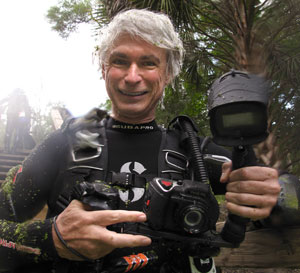 The rest of the 45 minute dive was uneventful as it was just too murky to really enjoy and experience the scenery. There seemed more silty sediment at the bottom and all sorts of stuff was floating around. Getting rid of the duckweed once you emerge from the water is almost impossible, even when using the shower next to the sink. Experienced divers will use a blast of air from their regulator to clear a patch of surface from duckweed before they emerge, but the little weeds will still be everywhere. All you can do is keep enough air in your tank for a second dive in the clear main basin a hundred yards away from the sink.
The rest of the 45 minute dive was uneventful as it was just too murky to really enjoy and experience the scenery. There seemed more silty sediment at the bottom and all sorts of stuff was floating around. Getting rid of the duckweed once you emerge from the water is almost impossible, even when using the shower next to the sink. Experienced divers will use a blast of air from their regulator to clear a patch of surface from duckweed before they emerge, but the little weeds will still be everywhere. All you can do is keep enough air in your tank for a second dive in the clear main basin a hundred yards away from the sink.
Chiefland, Manatee Springs main basin
The main basin at Manatee Springs is a popular swimming and snorkeling watering hole just a short distance away from the Suwannee river. The water is usually crystal-clear as the bowl is fed by the same underground spring that passes by Catfish sink. We both had over a thousand psi left in our tanks and so welcomed the chance to play in the clear water, washing off the duckweed in the process. It’s great fun to go down to the bottom where the underwater river blasts out of the rocks. The flow is so great that it’s hard to swim up to the entrance or even holding onto something, and your hair gets blown back and your mask would come off if you held your head sideways. Amazingly, some sort of mossy stuff grows on logs there, getting nearly ripped off 24/7, yet apparently thriving. The mouth was at perhaps 30 feet, yet freedivers came down and even stayed a bit to poke around, I don’t think I could ever do that.
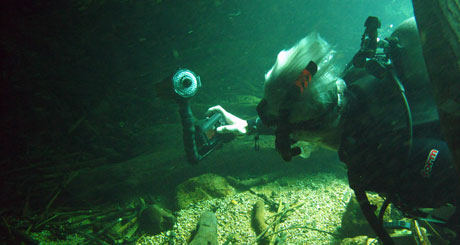
I breathed down my tank to about 250psi, then surfaced, leaving all the duckweed behind. On the walk back to the car to get changed I was looking forward to a serving of delicious chicken strips from the concession stand, and then perhaps a leisurely stroll on the wooden boardwalk down to Suwannee river. Unfortunately, there was a brand-new concessionaire who had just moved in a week ago and was still only selling a few items from a table. So no delicious chicken strips. And by the time we were all done with stowing away our gear, it was too late for a walk.
High Springs, Ginnie Springs
Ginnie Springs, near the small town of High Springs, is a Mecca to cave divers for its massive underground network of mapped-out caves and tunnels. It’s also very popular for certification dives thanks to the gin-clear water it gets its name from and the year-round 72 degree water temperature common to all Florida springs. We arrived on a very hot and sunny Sunday with lots of people enjoying the campground and the main basin. 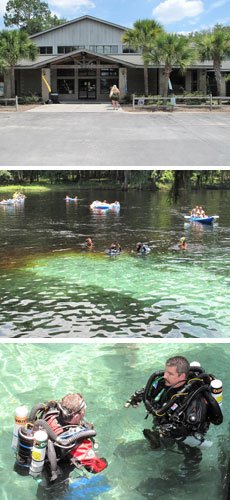 The check-in procedure at Ginny is on the cumbersome side, with youthful staff directing you around to sign releases, pay for things and so on. There seems quite a bit of unnecessary overhead, not all of the staffers seemed on top of things, and it seemed odd that divers had to pay $30 and cavers only $22 when the cave system is world famous and massive whereas open water divers have much less real estate to play around in.
The check-in procedure at Ginny is on the cumbersome side, with youthful staff directing you around to sign releases, pay for things and so on. There seems quite a bit of unnecessary overhead, not all of the staffers seemed on top of things, and it seemed odd that divers had to pay $30 and cavers only $22 when the cave system is world famous and massive whereas open water divers have much less real estate to play around in.
We needed to have our tanks filled, which only cost US$5 a pop. Again, staff was milling around but no one offered to help with the tanks. I finally grabbed one of the guys and he went to get help. Filling didn’t take long and we spent the time perusing the large shop filled with interesting gear, snacks, apparel, books and all sorts of stuff, but hardly any caver gear. Carol said this was because there was an excellent caver dive shop in High Springs.
Carol wanted to show me Devil’s Eye and Devil’s Ear before diving. Those are the two main entrances to the Ginnie Springs cave system, though you’d never know. Both are near the mouth of a small sidearm of the Santa Fe river, with the eye being a bit inside the small inlet and the ear just about where the river meets the spring inlet. The sidearm is extremely clear whereas the water of the Santa Fe is an opaque tannic brown. It's not dirty, it just looks like someone had swirled a giant tea bag in it. The two waters swirl and mix around the entrance, with the tannic waters winning out near Devil’s Ear, which was invisible in the tannic water as opposed to Devil’s Eye just a few yards away. There was a steady procession of cavers returning from their dives, most using rebreathers and lots of tech gear. I was watching two of them slowly finning up the inlet where they could exit at the end, making the walk to the parking lot with all their gear as brief as possible. I was fascinated (and a bit intimidated) by all their complicated, professional-looking equipment. I also thought that this was where Mark Fyvie had entered the Ginnie cave system one evening in March of 2008, never to emerge alive.
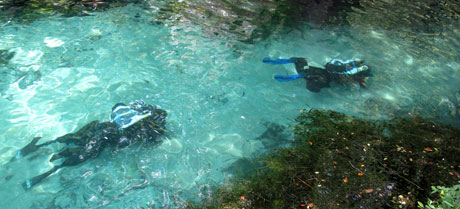
We then parked near the Ginnie Springs main basin and geared up in the stifling 100 degree heat. 7mm Scubapro wetsuit for me whereas Carol wore her 3mil. Getting in the water brought much welcome relief from the heat. A lot of happy, splashing, shouting people were swimming and snorkeling, and so the basin wasn’t quite as clear as the liquid from which it derived its name.
 At one end of the basin, at a depth of about 18 feet, lies the entrance to a largish cavern called “The Ballroom†for its generous proportions. The cavern is wedge-shaped and at an angle, so there is a substantial drop to about 50 feet at its far end where a thick steel grate prohibits further penetration. The grate was put in a good while ago as too many divers had gotten lost and died in the cave system behind. I don’t know if maps exist of that part of the system, or whether it is connected to the main Ginnie cave system that one enters via the Devil’s Eye/Ear.
At one end of the basin, at a depth of about 18 feet, lies the entrance to a largish cavern called “The Ballroom†for its generous proportions. The cavern is wedge-shaped and at an angle, so there is a substantial drop to about 50 feet at its far end where a thick steel grate prohibits further penetration. The grate was put in a good while ago as too many divers had gotten lost and died in the cave system behind. I don’t know if maps exist of that part of the system, or whether it is connected to the main Ginnie cave system that one enters via the Devil’s Eye/Ear.
The flow of fresh spring water from the grate is very strong. I hung on to the grate, using my divelight to shine into the area beyond while the flow blew back my hair. It’s a great feeling. The rock inside the cavern, which, amazingly, we had all to ourselves for the entire 35 minutes we were in there, is all white and immaculate. I began exploring the nooks and crannies and even entered a side chamber that beckoned. A small dive light is enough to light things up in all the white rock.
The view from inside the cavern towards the entrance is spectacular, with sunlight streaming in, framed by the rock. It’s a sight that seems perfect for pictures, but is quite difficult to catch as the dynamic range between all dark inside and very bright outside is so large.
The water inside The Ballroom was indeed gin-clear. It felt like it wasn’t there at all, without any of the ubiquitous floating debris that’s almost always present in water. My gear worked very well, as it did throughout the trip, but I still feel like I am having tunnel vision and it’s difficult to look anywhere but straight ahead. I resolved trying a clear-skirt mask again to see if it makes a difference.
As we left The Ballroom a good half dozen divers came in. We’d been lucky. After we dried off and got out of our gear and into dry clothes we drove back to the lodge. Though it was still early, the snack bar was already closed, so, again no chicken strips (somehow I associate those with diving). Overall, things seemed to be closed a lot during this Florida trip. Diners closed on Sunday afternoons, snack bars closed, restaurants open only for minimal hours. I’d have thought shops would be extra-eager to serve and sell during tough economic times, but apparently not.
Ginnie Springs left a mixed impression. Carol, who doesn’t like crowds and was put off by the increasing commercialization of the once pristine place, had little patience with the uninspired staff and college spring break flavor of the place. So I am not sure if we’ll be back there. Once we got back to the hotel, the neon-emblazoned Fleetwood diner (formerly Floyd's) was, of course, closed. Which was just as well as we ended up having a truly delicious dinner at the historic The Great Outdoors Café in town.
Williston, Blue Grotto
Like Ginnie Springs, Blue Grotto near Williston, just 30 miles or so from Ginnie, was new to me. It’s located within a quarter mile of Devil’s Den on the other side of the highway. The approach is extremely low key, just a dirt road through a rural neighborhood with a small house here and there. A rickedy sign and poster announce Blue Grotto and the cost of diving there (US$40 per diver). There’s a home on the right and a shack to the left.
 The man inside the shack is Ed Paradiso, owner and operator of Blue Grotto. Ed doesn’t say much at first and it’s almost a bit awkward standing there. He recognized Carol after a bit and seemed surprised. Somehow he thought she had died at Ginnie Springs some years ago--clearly a case of mistaken identity and Ed was glad that the news of Carol’s demise was greatly exaggerated.
The man inside the shack is Ed Paradiso, owner and operator of Blue Grotto. Ed doesn’t say much at first and it’s almost a bit awkward standing there. He recognized Carol after a bit and seemed surprised. Somehow he thought she had died at Ginnie Springs some years ago--clearly a case of mistaken identity and Ed was glad that the news of Carol’s demise was greatly exaggerated.
While Carol and Ed catch up on what’s been happening I watch the very good orientation video, starring Ed himself. I must say that the video intimidated me a bit, what with Ed talking about the bottom of the cavern’s loop dive being at 100 feet. We get our tanks filled and Ed suggests we take along a cleverly designed dive light contraption consisting of two powerful lights attached to a hefty battery. It doesn’t have a mount or anything and so we use plastic zip ties to attach the Canon G10's housing on top of it and then head for the grotto.
The Blue Grotto cavern is another natural geologic formation carved by water from the Florida aquifer into the limestone. It’s part sinkhole and part wedge-shaped underwater cavern going down to over a hundred feet. The sinkhole part, however, is sort of like an open amphitheater on the one side, facing a vertical rock face on top of the cavern entrance. Steps go down from the park/picnic area to above-water decking. Large retaining walls hold back the apparently much softer slope opposite the cavern. There are little fish in the water and some algae stuff, but not much. There is no one else there, and the water seems extremely clear. That’s confirmed as we get in. Wow. It’s always hard to estimate actual visibility in feet, but this was the best I have ever seen. Carol later tagged it at 300-plus feet. It was like air, with no floating debris or particles of any kind.
The exposed side of Blue Grotto is like a large bowl that is part open water and part cavern. The bottom slopes down to a massive plate called “peace rock.†It’s a slab that at some point in the cavern’s history must have broken off the ceiling and now rests at the bottom, inviting you to sit on it and peruse the stunning vista from a depth of about 40-45 feet. Looking up from there, you see the various dive platforms, the sunlight shining through the water as glorious rays, an air bell on the underside of the cavern ceiling, and the myriad of reflections from the scenery above. Carol’s taking pictures of me floating through the clear water, and then it’s time to descend into the dark depths behind Peace Rock.
I had read about Blue Grotto but couldn’t quite get a sense of what the various reports seemed to describe as a circular descent and ascent along a guideline. I somehow envisioned a cave-like tube. In reality, there is a lot of rock in the center of the wedge-like cavern that tilts down at a steep angle. The thick guideline rope takes a counterclock-wise turn around all this rock, making it feel like a real cave dive. My heart rate went up quite a bit as I followed Carol down into the dark clear water behind the rock. The powerful video lighting system illuminated our descent into all the white rock. Blue Grotto actually has a high-wattage lighting system mounted on the ceiling near the entrance, but it was off that day, so I don’t know how much it lights up the darker, deeper parts of the grotto. I had my own dive light with me, of course, and so I soon relaxed and took in the majestic scenery, always making sure I stayed by the line.
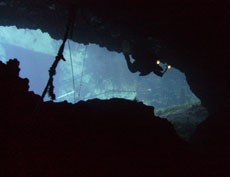 The descent from 40 feet to the bottom of the guide line, which is at about 83 feet, took only four minutes or so. Carol explored a bit, touching the sandy bottom and thus logging a hundred foot dive. I had not seen the blue light of the cavern entrance during the descent, though I am told that if you’re looking for it, it’s there, thus making Blue Grotto accessible to Open Water divers as opposed to requiring cavern or cave certification. We then did a slow eight to ten minute ascent with the very blue Grotto entrance coming into view first as a small slit, then growing and shining ever brighter. It is a stunning sight and it’s instantly clear why it’s called the Blue Grotto. After we got back to Peace Rock I regretted not having taken more time, just as in Honduras I had regretted having gone through Mary’s Place and Calvin’s Crack much too quickly on my first time. I plan on being back for sure, but it’s hard to imagine conditions ever being this perfect again and the water this clear.
The descent from 40 feet to the bottom of the guide line, which is at about 83 feet, took only four minutes or so. Carol explored a bit, touching the sandy bottom and thus logging a hundred foot dive. I had not seen the blue light of the cavern entrance during the descent, though I am told that if you’re looking for it, it’s there, thus making Blue Grotto accessible to Open Water divers as opposed to requiring cavern or cave certification. We then did a slow eight to ten minute ascent with the very blue Grotto entrance coming into view first as a small slit, then growing and shining ever brighter. It is a stunning sight and it’s instantly clear why it’s called the Blue Grotto. After we got back to Peace Rock I regretted not having taken more time, just as in Honduras I had regretted having gone through Mary’s Place and Calvin’s Crack much too quickly on my first time. I plan on being back for sure, but it’s hard to imagine conditions ever being this perfect again and the water this clear.
One of Blue Grotto’s attractions is an air bell mounted on the underside of the cavern ceiling at about 22 feet (depth depends on water level, of course). The bell actually feels a little weird. There is nothing to hold onto, you can’t really see out very well, and the acoustics are such that you can barely understand each other. It’s an interesting curiosity, but not the vista point I had expected it to be.
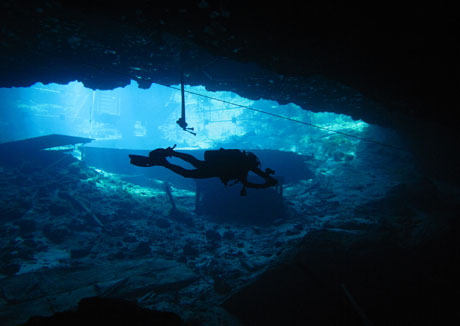
We surfaced after 45 minutes, having enough air left (after I switched tanks with Carol who still uses less than I) for a second half-hour fun and photography dive.
From what I am told, the number of people diving at Blue Grotto pretty much determines visibility. There are times when the place is full of certification divers, and since the bottom is silty, visibility can go down the drain very quickly. This probably won’t affect the water deeper down, but to get the full effect of this awesome place, come early, and during the week.
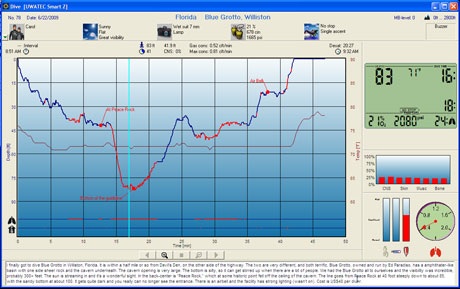
Anyone wondering whether to choose Blue Grotto or Devil’s Den, the two venues being so close to each other, do both. They are totally different, each spectacular in its own right. And it’s easy to dive both in one day.
Williston, Devil’s Den
Devil’s Den was the first dive when I took my advanced scuba class and I will never forget it. It’ll probably always be one of my very favorite dive sites. The prehistoric setting with the groves, the sinkhole with just a small circle on top that lets in light, the stairs down into the cavern through sheer rock, and just the whole atmosphere of the place are simply priceless. And the diving is wonderful, too.
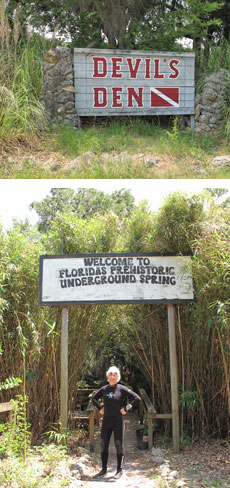 Devil’s Den is not a large site, nor is it very deep. You may see 50 feet or a bit more if the water level is high. Management had rebuilt the wooden stairs descending into the sinkhole and terminating on the platform built atop the central debris cone. The water was clear as always, though without the absolute clarity I had seen prior as several teams of divers had used the facility before us.
Devil’s Den is not a large site, nor is it very deep. You may see 50 feet or a bit more if the water level is high. Management had rebuilt the wooden stairs descending into the sinkhole and terminating on the platform built atop the central debris cone. The water was clear as always, though without the absolute clarity I had seen prior as several teams of divers had used the facility before us.
When you look at the water in Devil’s Devil’s Den, it looks like it is about four feet deep, an interesting optical illusion. We descended into the 72 degree water which seemed fairly dark at first so that we turned on our dive lights to explore the rocks and formations. The cool thing about Devil’s Den is that even though the site is limited, you can dive behind and under rocks and it all looks like you’re exploring cave.
This time we went deeper and ventured into nooks and crannies more than before. We saw the several areas that are blocked off from further exploration. Beyond the grates, the cavern continues for what looked to me like a good distance, down as well as out. I probed with my light and wondered how far the system had been explored. I afterwards asked Rowena, Devil’s Den’s manager, and she claimed it was only a few feet before it petered out. I also asked Bill and Diane Oestreich of Bird’s Underwater, who are very advanced cave divers. They, too, said there wasn’t much, and that it had taken Bill five minutes to get in and 15 minutes to get back out when he ventured farther years ago. Maybe it was an illusion, but to me it looked as if there was much more to it.
We spent a full 45 minutes exploring during one full rotation of the den. As we came back up towards the debris cone, sun rays shone down into the water, making for a fairy tale magical atmosphere. And that was at almost 5PM. I took a bunch of pictures.
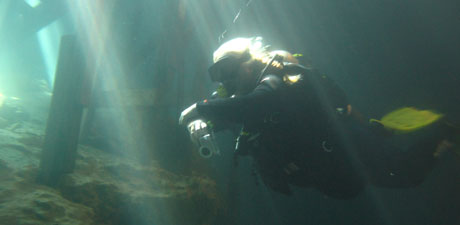
Later, after I got out of my gear and stowed it away in the back of our Pontiac Vibe rental (a small SUV that made for a perfect dive vehicle), I walked around the aquatic park facilities that someone had built as part of Devil's Den several years ago. It seems to be just sitting there, unmaintained, which is unfortunate as the whole setting would make for a wonderful, and wonderfully romantic, getaway.
So there. I look forward to my upcoming trips to Turks and Caicos in the Caribbean and to Cozumel later this year, but diving the springs and rivers of Florida will always be among my favorites. And it's a terrific bargain for anyone willing to do their own thing.
Posted by conradb212 at July 6, 2009 10:01 PM








